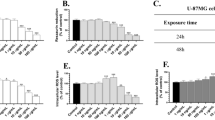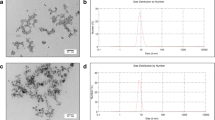Abstract
Glioblastomas (GBM) are aggressive brain tumors with very poor prognosis. While silver nanoparticles represent a potential new strategy for anticancer therapy, the silver/silver chloride nanoparticles (Ag/AgCl-NPs) have microbicidal activity, but had not been tested against tumor cells. Here, we analyzed the effect of biogenically produced Ag/AgCl-NPs (from yeast cultures) on the proliferation of GBM02 glioblastoma cells (and of human astrocytes) by automated, image-based high-content analysis (HCA). We compared the effect of 0.1–5.0 µg mL−1 Ag/AgCl-NPs with that of 9.7–48.5 µg mL−1 temozolomide (TMZ, chemotherapy drug currently used to treat glioblastomas), alone or in combination. At higher concentrations, Ag/AgCl-NPs inhibited GBM02 proliferation more effectively than TMZ (up to 82 and 62% inhibition, respectively), while the opposite occurred at lower concentrations (up to 23 and 53% inhibition, for Ag/AgCl-NPs and TMZ, respectively). The combined treatment (Ag/AgCl-NPs + TMZ) inhibited GBM02 proliferation by 54–83%. Ag/AgCl-NPs had a reduced effect on astrocyte proliferation compared with TMZ, and Ag/AgCl-NPs + TMZ inhibited astrocyte proliferation by 5–42%. The growth rate and population doubling time analyses confirmed that treatment with Ag/AgCl-NPs was more effective against GBM02 cells than TMZ (~ 67-fold), and less aggressive to astrocytes, while Ag/AgCl-NP + TMZ treatment was no more effective against GBM02 cells than Ag/AgCl-NPs monotherapy. Taken together, our data indicate that 2.5 µg mL−1 Ag/AgCl-NPs represents the safest dose tested here, which affects GBM02 proliferation, with limited effect on astrocytes. Our findings show that HCA is a useful approach to evaluate the antiproliferative effect of nanoparticles against tumor cells.


Similar content being viewed by others
References
Allahverdiyev A, Abamor EŞ, Bagirova M et al (2011) Antileishmanial effect of silver nanoparticles and their enhanced antiparasitic activity under ultraviolet light. Int J Nanomed 6:2705–2714. https://doi.org/10.2147/IJN.S23883
Alves TR, Lima FRS, Kahn SA et al (2011) Glioblastoma cells: a heterogeneous and fatal tumor interacting with the parenchyma. Life Sci 89:532–539. https://doi.org/10.1016/j.lfs.2011.04.022
Arvold ND, Reardon DA (2014) Treatment options and outcomes for glioblastoma in the elderly patient. Clin Interv Aging 9:357–367. https://doi.org/10.2147/CIA.S44259
AshaRani P, Hande MP, Valiyaveettil S (2009) Anti-proliferative activity of silver nanoparticles. BMC Cell Biol 10:65. https://doi.org/10.1186/1471-2121-10-65
Assanga I (2013) Cell growth curves for different cell lines and their relationship with biological activities. Int J Biotechnol Mol Biol Res 4:60–70. https://doi.org/10.5897/IJBMBR2013.0154
Balça-Silva J, Matias D, do Carmo A et al (2015) Tamoxifen in combination with temozolomide induce a synergistic inhibition of PKC-pan in GBM cell lines. Biochim Biophys Acta Gen Subj 1850:722–732. https://doi.org/10.1016/j.bbagen.2014.12.022
Beier D, Schulz JB, Beier CP (2011) Chemoresistance of glioblastoma cancer stem cells—much more complex than expected. Mol Cancer 10:128. https://doi.org/10.1186/1476-4598-10-128
Brayden DJ, Cryan S-A, Dawson KA et al (2015) High-content analysis for drug delivery and nanoparticle applications. Drug Discov Today 20:942–957. https://doi.org/10.1016/j.drudis.2015.04.001
Buttacavoli M, Albanese NN, Di Cara G et al (2018) Anticancer activity of biogenerated silver nanoparticles: an integrated proteomic investigation. Oncotarget 9:9685–9705. https://doi.org/10.18632/oncotarget.23859
Chan GKY, Kleinheinz TL, Peterson D, Moffat JG (2013) A simple high-content cell cycle assay reveals frequent discrepancies between cell number and ATP and MTS proliferation assays. PLoS ONE 8:e63583. https://doi.org/10.1371/journal.pone.0063583
Devi TB, Ahmaruzzaman M, Begum S et al (2016) A rapid, facile and green synthesis of Ag@AgCl nanoparticles for the effective reduction of 2,4-dinitrophenyl hydrazine. New J Chem 40:1497–1506. https://doi.org/10.1039/C5NJ02367J
Diniz LP, Almeida JC, Tortelli V et al (2012) Astrocyte-induced synaptogenesis is mediated by transforming growth factor β signaling through modulation of d-serine levels in cerebral cortex neurons. J Biol Chem 287:41432–41445. https://doi.org/10.1074/jbc.M112.380824
Durán N, Durán M, de Jesus MB et al (2016a) Silver nanoparticles: a new view on mechanistic aspects on antimicrobial activity. Nanomed Nanotech Biol Med 12:789–799. https://doi.org/10.1016/j.nano.2015.11.016
Durán N, Nakazato G, Seabra AB (2016b) Antimicrobial activity of biogenic silver nanoparticles, and silver chloride nanoparticles: an overview and comments. Appl Microbiol Biotechnol 100:6555–6570. https://doi.org/10.1007/s00253-016-7657-7
Eugenio M, Müller N, Frasés S et al (2016) Yeast-derived biosynthesis of silver/silver chloride nanoparticles and their antiproliferative activity against bacteria. RSC Adv 6:9893–9904. https://doi.org/10.1039/C5RA22727E
Faria J, Romão L, Martins S et al (2006) Interactive properties of human glioblastoma cells with brain neurons in culture and neuronal modulation of glial laminin organization. Differentiation 74:562–572. https://doi.org/10.1111/j.1432-0436.2006.00090.x
Gavish A, Krayzler E, Nagler R (2016) Tumor growth and cell proliferation rate in human oral cancer. Arch Med Res 47:271–274. https://doi.org/10.1016/j.arcmed.2016.07.007
Glaser T, Han I, Wu L, Zeng X (2017) Targeted nanotechnology in glioblastoma multiforme. Front Pharmacol 8:166. https://doi.org/10.3389/fphar.2017.00166
Goldlust SA, Turner GM, Goren JF (2008) Glioblastoma multiforme: multidisciplinary care and advances in therapy. Hosp Physician 1:9–23
Hsin Y-H, Chen C-F, Huang S et al (2008) The apoptotic effect of nanosilver is mediated by a ROS- and JNK-dependent mechanism involving the mitochondrial pathway in NIH3T3 cells. Toxicol Lett 179:130–139. https://doi.org/10.1016/j.toxlet.2008.04.015
Huang J, Li Q, Sun D et al (2007) Biosynthesis of silver and gold nanoparticles by novel sundried Cinnamomum camphora leaf. Nanotechnology 18:105104. https://doi.org/10.1088/0957-4484/18/10/105104
Jain P, Aggarwal V (2012) Synthesis, characterization and antimicrobial effects of silver nanoparticles from microorganisms—a review. Int J Nano Mater Sci 1:108–120
Jeyaraj M, Sathishkumar G, Sivanandhan G et al (2013) Biogenic silver nanoparticles for cancer treatment: an experimental report. Colloids Surf B Biointerfaces 106:86–92. https://doi.org/10.1016/j.colsurfb.2013.01.027
Kang Y, Jung J-Y, Cho D et al (2016) Antimicrobial silver chloride nanoparticles stabilized with chitosan oligomer for the healing of burns. Materials 9:pii:E215. https://doi.org/10.3390/ma9040215
Liang P, Shi H, Zhu W et al (2017) Silver nanoparticles enhance the sensitivity of temozolomide on human glioma cells. Oncotarget 8:7533–7539. https://doi.org/10.18632/oncotarget.13503
Locatelli E, Broggi F, Ponti J et al (2012) Lipophilic silver nanoparticles and their polymeric entrapment into targeted-PEG-based micelles for the treatment of glioblastoma. Adv Healthc Mater 1:342–347. https://doi.org/10.1002/adhm.201100047
Locatelli E, Naddaka M, Uboldi C et al (2014) Targeted delivery of silver nanoparticles and alisertib: in vitro and in vivo synergistic effect against glioblastoma. Nanomedicine 9:839–849. https://doi.org/10.2217/nnm.14.1
Louis DN, Ohgaki H, Wiestler OD et al (2007) The 2007 WHO classification of tumours of the central nervous system. Acta Neuropathol 114:97–109. https://doi.org/10.1007/s00401-007-0243-4
MacEwan SR, Callahan DJ, Chilkoti A (2010) Stimulus-responsive macromolecules and nanoparticles for cancer drug delivery. Nanomedicine 5:793–806. https://doi.org/10.2217/nnm.10.50
Naqvi SZ, Kiran U, Ali MI et al (2013) Combined efficacy of biologically synthesized silver nanoparticles and different antibiotics against multidrug-resistant bacteria. Int J Nanomed 8:3187–3195. https://doi.org/10.2147/IJN.S49284
Piao MJ, Kang KA, Lee IK et al (2011) Silver nanoparticles induce oxidative cell damage in human liver cells through inhibition of reduced glutathione and induction of mitochondria-involved apoptosis. Toxicol Lett 201:92–100. https://doi.org/10.1016/j.toxlet.2010.12.010
Raizer JJ, Fitzner KA, Jacobs DI et al (2015) Economics of malignant gliomas: a critical review. J Oncol Pract 11:e59–e65. https://doi.org/10.1200/JOP.2012.000560
Ramery E, O’Brien PJ (2014) Evaluation of the cytotoxicity of organic dust components on THP1 monocytes-derived macrophages using high content analysis. Environ Toxicol 29:310–319. https://doi.org/10.1002/tox.21759
Ramirez YP, Weatherbee JL, Wheelhouse RT, Ross AH (2013) Glioblastoma multiforme therapy and mechanisms of resistance. Pharmaceuticals 6:1475–1506. https://doi.org/10.3390/ph6121475
Rosarin FS, Arulmozhi V, Nagarajan S, Mirunalini S (2013) Antiproliferative effect of silver nanoparticles synthesized using amla on Hep2 cell line. Asian Pac J Trop Med 6:1–10. https://doi.org/10.1016/S1995-7645(12)60193-X
Rutberg FG, Dubina MV, Kolikov VA et al (2008) Effect of silver oxide nanoparticles on tumor growth in vivo. Dokl Biochem Biophys 421:191–193
Sharma S, Chockalingam S, Sanpui P et al (2014) Silver nanoparticles impregnated alginate-chitosan-blended nanocarrier induces apoptosis in human glioblastoma cells. Adv Healthc Mater 3:106–114. https://doi.org/10.1002/adhm.201300090
Sherley JL, Stadler PB, Stadler JS (1995) A quantitative method for the analysis of mammalian cell proliferation in culture in terms of dividing and non-dividing cells. Cell Prolif 28:137–144
Silva HFO, Lima KMG, Cardoso MB et al (2015) Doxycycline conjugated with polyvinylpyrrolidone-encapsulated silver nanoparticles: a polymer’s malevolent touch against Escherichia coli. RSC Adv 5:66886–66893. https://doi.org/10.1039/C5RA10880B
Sriram MI, Kanth SBM, Kalishwaralal K, Gurunathan S (2010) Antitumor activity of silver nanoparticles in Dalton’s lymphoma ascites tumor model. Int J Nanomed 5:753–762. https://doi.org/10.2147/IJN.S11727
Stengl A, Hörl D, Leonhardt H, Helma J (2017) A simple and sensitive high-content assay for the characterization of antiproliferative therapeutic antibodies. SLAS Discov 22:309–315. https://doi.org/10.1177/1087057116677821
Stojiljković A, Kuehni-Boghenbor K, Gaschen V et al (2016) High-content analysis of factors affecting gold nanoparticle uptake by neuronal and microglial cells in culture. Nanoscale 8:16650–16661. https://doi.org/10.1039/C6NR05723C
Stupp R, Hegi ME, Mason WP et al (2009) Effects of radiotherapy with concomitant and adjuvant temozolomide versus radiotherapy alone on survival in glioblastoma in a randomised phase III study: 5-year analysis of the EORTC-NCIC trial. Lancet Oncol 10:459–466. https://doi.org/10.1016/S1470-2045(09)70025-7
Urbańska K, Pająk B, Orzechowski A et al (2015) The effect of silver nanoparticles (AgNPs) on proliferation and apoptosis of in ovo cultured glioblastoma multiforme (GBM) cells. Nanoscale Res Lett 10:98. https://doi.org/10.1186/s11671-015-0823-5
Usaj M, Styles EB, Verster AJ et al (2016) High-content screening for quantitative cell biology. Trends Cell Biol 26:598–611. https://doi.org/10.1016/j.tcb.2016.03.008
Vigneshwaran N, Ashtaputre NM, Varadarajan PV et al (2007) Biological synthesis of silver nanoparticles using the fungus Aspergillus flavus. Mater Lett 61:1413–1418. https://doi.org/10.1016/j.matlet.2006.07.042
Villanueva-Ibáñez M, Yañez-Cruz MG, Álvarez-García R et al (2015) Aqueous corn husk extract—mediated green synthesis of AgCl and Ag nanoparticles. Mater Lett 152:166–169. https://doi.org/10.1016/j.matlet.2015.03.097
Wen PY, Kesari S (2008) Malignant gliomas in adults. N Engl J Med 359:492–507. https://doi.org/10.1056/NEJMra0708126
Zanella F, Lorens JB, Link W (2010) High content screening: seeing is believing. Trends Biotechnol 28:237–245. https://doi.org/10.1016/j.tibtech.2010.02.005
Acknowledgements
This work was supported by the National Council for Scientific and Technological Development (CNPq), the Carlos Chagas Filho Foundation for Research Support of the State of Rio de Janeiro (FAPERJ) and the Coordination for the Improvement of Higher Education Personnel (CAPES).
Author information
Authors and Affiliations
Corresponding author
Ethics declarations
Conflict of interest
The authors declare no conflict of interest.
Electronic supplementary material
Below is the link to the electronic supplementary material.
Supplementary Fig.
1. Representative images showing the effect of Ag/AgCl-NPs on the proliferation of GBM02 cells and astrocytes. Cells labeled with Hoechst 33258 were left untreated, or were treated with different concentrations of Ag/AgCl-NPs (0.1, 0.5, 1.0, 2.5 and 5.0 µg mL-1) for 72 h. Images are representative of 3 independent experiments (6 fields imaged per experimental condition, in each experiments). Scale bar: 50 µm. (TIFF 20027 kb)
Supplementary Fig.
2. Representative images showing the effect of TMZ on the proliferation of GBM02 cells and astrocytes. Cells labeled with Hoechst 33258 were left untreated, or were treated with different concentrations of TMZ (9.7, 19.4, 29.1, 38.5 and 48.5 µg mL−1) for 72 h. Images are representative of 3 independent experiments (6 fields imaged per experimental condition, in each experiments). Scale bar: 50 µm. (TIFF 20027 kb)
Supplementary Fig.
3. Representative images showing the effect of Ag/AgCl-NPs + TMZ on the proliferation of GBM02 cells and astrocytes. Cells labeled with Hoechst 33258 were left untreated, or were treated with different concentrations of Ag/AgCl-NPs + TMZ (0.1 + 9.7, 0.5 + 19.4, 1.0 + 29.1, 2.5 + 38.5 and 5.0 + 48.5 µg mL−1) for 72 h. Images are representative of 3 independent experiments (6 fields imaged per experimental condition, in each experiments). Scale bar: 50 µm. (TIFF 18706 kb)
Rights and permissions
About this article
Cite this article
Eugenio, M., Campanati, L., Müller, N. et al. Silver/silver chloride nanoparticles inhibit the proliferation of human glioblastoma cells. Cytotechnology 70, 1607–1618 (2018). https://doi.org/10.1007/s10616-018-0253-1
Received:
Accepted:
Published:
Issue Date:
DOI: https://doi.org/10.1007/s10616-018-0253-1




